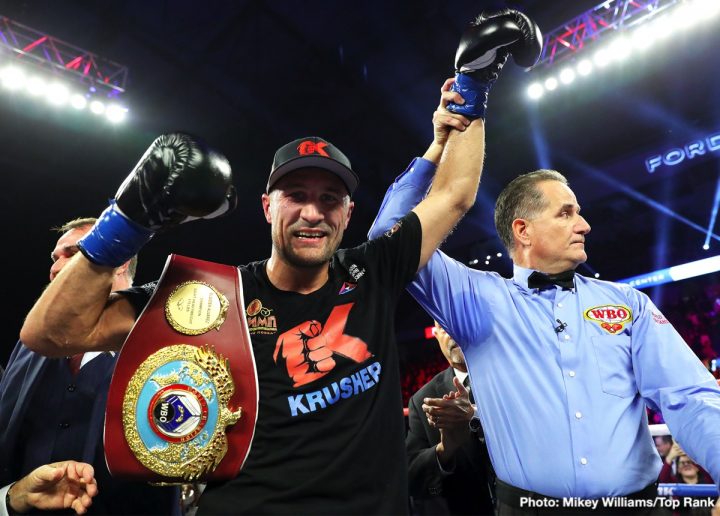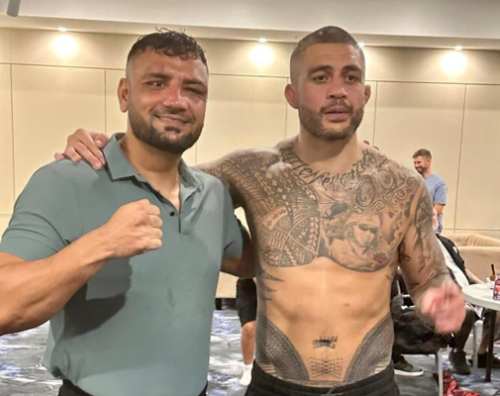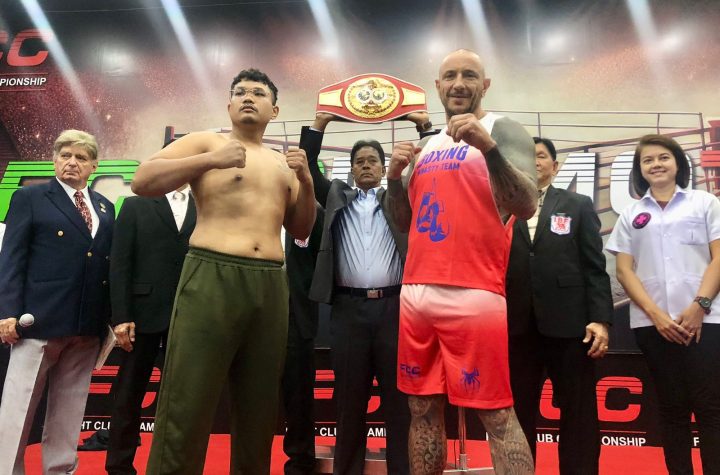
By Joseph Hirsch
Boxingnews24.com
In the runup to the rematch between Sergey “Krusher” Kovalev and Eleider “Storm” Alvarez, I joked with a fellow boxing aficionado that “Kovalev” might be Russian for “Broner of the Frozen Tundra.” Kovalev was an elite fighter who had lost three of his last six fights, and whose outside-the-ring struggles and problems went from rumors to hard facts, first in the form of a very rough car crash, and then in the form of a charge of felony assault. It should be pointed out, though, that if we’re going to start judging fighters on their behavior outside of the ring rather than inside of it, then the Hall of Fame could probably be moved into a broom closet.
Also like Adrien “the Problem” Broner, Sergey Kovalev was starting to develop the terrible habit in the ring of getting you, as a fan, to believe that he was going to pull it off, break the psychic spell of the curse that the second loss to Ward put on him, only to let it slip away after you’d invested yourself in him again.
That’s pretty much what happened in the first Alvarez fight.
Understand, I had Kovalev winning his first scrape with Andre “Son of God” Ward by a small margin, and I never bought into the heavily-peddled narrative that Kovalev was some soulless bully who relied more on intimidation than technique to get the job done. That being said, as I watched that first fight between Kovalev and Alvarez, wanting the man to reclaim his crown, I got a sinking feeling that he would do some good work, bank some early rounds by using his punishing power-jab (as Max Kellerman called it) and that he would lose focus or self-belief down the stretch and give up a lopsided decision to Alvarez.
Instead he got knocked down, and then knocked out, and in a much more convincing fashion than against Ward (there is still some dispute among fans whether or not Ward went below the belt against Kovalev, or if the Krusher’s satin trunks may have been pulled too high).
Things didn’t look good for Kovalev going into the rematch with Alvarez. That it was scheduled so soon after the first match didn’t bode well, and it reeked of a desire for one last payday before hanging up the gloves for good and donning a promoter’s hat from here on out. That Sergey Kovalev had switched trainers (again), this time to Buddy McGirt, also gave one pause. Sure, Buddy was a good fighter in his day, and his wise counsel had helped extend the shelf-life of Arturo Gatti, who’d taken so much attrition in the early part of his career that Floyd “Money” Mayweather once joked his many plastic surgeries made him look Japanese.
But what, exactly, was Buddy going to do to get Kovalev back on track?
We got our answer last Saturday. Kovalev was not out to crush Alvarez early, or to blitz his opponent into a quick KO.
Kovalev was taking his time, parceling out those power jabs and stepping back whenever Alvarez invited him to dance close.
Whether it was McGirt alone or Kovalev’s trip to a remote monastery for some soul-searching, or some alchemy between the trainer, Kovalev, and the man’s religious counsel, Sergey Kovalev went back to what really made him a great force at light-heavy, and he also demonstrated some newfound maturity, patience, and a couple novel wrinkles to boot.
No, he didn’t have that Liston-like mantel of invincibility (Ward had stripped him of that a long time ago), but he didn’t need it with the IQ he displayed.
Speaking of Ward, Eleider Alvarez should have read the dossier Andre and his trainer, Virgil Hunter, compiled on the heavy-punching Russian in the runup to the Ward-Kovalev rematch. As Ward said, Sergey is great from one distance and not so great from others.
Thus the trick was not to fight him at that distance, and force him to fight at the other ones, where he was well-outside his comfort zone.
Ward didn’t specify where Kovalev was weak or where Krusher was great in his analysis, but he didn’t have to. Everyone knows that Kovalev is a genius at jabbing range, that his shelling up behind his shoulder (with chin tucked tight) makes him hard to hit from the outside, and that he’s a master at breaking guys down who try to remain at a distance and find themselves just at the edge of his punching range.
It’s an old axiom going back to the days of fight scribes like Budd Schulberg or W.C. Heinz that you don’t hook with a hooker but you can jab with a jabber, but Kovalev is the exception to that rule. He is simply murder from jab range and even Andre Ward didn’t want to try to best him in that dimension when they met twice.
Conversely, Kovalev is far less comfortable on the inside, where reflex (rather than timing) is crucial, and the breadbasket (as the old boxing heads call the stomach) is easier to drub. The knock on Kovalev from some of his detractors is that, unlike most fighters who don’t like it to the body (nobody does), he really doesn’t like to ship punishment to the midsection.
If Alvarez wanted to beat Kovalev in the rematch and keep his belt, he had to close the distance, mix it inside and downstairs. Instead he fought at Kovalev’s preferred range (ceding the generalship and clean punching dimensions totally to Krusher).
The question then is why didn’t Alvarez get inside? And the answer is in the footwork that Kovalev displayed, backed up by the experience of having twice fought one of the best distance-closers in the game. Aside from maybe Jorge Paez, Kostya Tszyu, and a small number of other fighters, Ward was one of the best at leaping without paying a price for the lunge. He jumped toward Kovalev without running into the counters or checks that naturally get sprung like traps when fighters get reckless like this. “If he leaps, he sleeps,” as Larry Merchant once said. “Prince” Naseem Hamed, known for his unorthodox style backed by prodigious power and limitless self-belief, leaped one too many times against Kevin Kelly, and while he didn’t get knocked out, he did get dumped on his keister. The only other guy who closed distance in one bound better than Ward (and with his head down!) was Bernard Hopkins. And even if you are the rare fighter who can get away with that technique most of the time, there will be times when it fails you. Even the great Andre Ward suffered a knockdown against Kovalev while going forward (his only other taste of canvas in the pros coming via criminally-underrated journeyman Darnell Boone).
Kovalev respected Alvarez, which also helped him to beat him. When he got close enough to allow Alvarez to leap so that even a miss wouldn’t put him out of position, the Krusher would pull back and reset. Kovalev fought smart, pressed his advantages but never pressed his luck, never rushed.
As the old quote from legendary actor Clint Eastwood has it, “a man’s got to know his limitations,” and Kovalev was starting to respect Father Time (in terms of not overtraining before the fight and not loading up on power shots in the early going). He also respected and seemed to really bond with his trainer (contra the static he had with John David Jackson). Kovalev also didn’t go looking to appeal to the ref about arguably borderline shots, and he was relaxed and respectful in the runup to the rematch with Eleider Alvarez.
He was less of a bully (if he’d ever been one) and more of a boxer, invoked less menace and a bit more of a chess master’s mentality.
“Speed kills” is axiomatic in boxing, but the truth is also that timing neutralizes speed. If this weren’t true, someone like Jesus Soto Karass could never have landed a glove on someone like Andre Berto, and boxers with dynamite in their fists (albeit long-fused, slow-burn dynamite) like Carlos Monzon, Kelly Pavlik, or Bob Foster could have never gotten as far as they did or beaten men twice as fast as them.
And speaking of a great light-heavyweight like Bob Foster, how far away from being in a “Top Ten” conversation regarding all-time light-heavies is Sergey Kovalev? Any way you slice it, he should either be in or close to cracking your top ten.
The question gets a little harder to answer, and a bit more complicated, when one surveys the veritable Murderers’ Row that is light-heavyweight right now. Even the men relegated to gatekeeper status at light-heavy are either savvy spoilers (a la Isaac Chilemba) or guys who can be behind on the cards and change the complexion of the fight with one punch and send your butt out of the ring (a la Joseph Smith).
Make no mistake: Kovalev is a lion, but he’s an ageing one with a thorn in his paw, surrounded by a pride of young and hungry cats who are looking at him and that belt dangling around his waist as if it might as well be a medium-rare gazelle.
Unification scraps could be over the near-horizon, regardless of what happens between Alvarez and Kovalev from this point forward. How would the thirty-five year-old Kovalev fare against either Dmitry Bivol or Oleksandr Gvozdyk?
Dmitry Bivol first has to get past Joe Smith Sr., who is a puncher in a boxer-puncher’s division and may tag Bivol with that one shot that leaves him cold. But I don’t think so.
Bivol is rightly touted as a very good, perhaps great boxer, but his orthodoxy may be his downfall in a fight with Sergey Kovalev, since he may oblige by trying to win a war of the jabs against a man, who, while a little older and a little slower, still has the murderous pop, timing, and experience to bide his time and probably get a late stoppage.
Also, while one never wants to hold something against a boxer which he can’t change, the placement of Bivol’s cheekbones (very high) means that if Kovalev can start some swelling there, it will be easy to blind Bivol in at least one eye, at which point he is at a dangerous or maybe disastrous disadvantage.
Oleksandr Gvozdyk is an entirely different animal, and if he were not stablemates with the brilliant Oleksandr Usyk and otherworldly Vasyl Lomachenko, he might be considered the best of the high-pedigreed Ukrainians currently dominating multiple divisions. Gvozdyk is lowkey and does not boast an outsized personality or incredibly flashy footwork, nor has he successfully campaigned across multiple weight classes as a pro. That said, it isn’t outside of the realm of possibility that however slowly and surely he gets there, he may end up at the top or near the top of the pound-for-pound list, as things shake out. He is the most underrated elite boxer and the most well-rounded (aside from maybe Naoya Inoue or Errol Spence).
What Gvozdyk did to “Superman” Stevenson shouldn’t be diminished merely because of Stevenson’s age or his inactivity. Sure, Adonis Stevenson (who thankfully recovered from his coma) was very reticent in defending his crown and making title defenses, but his own smart and concerted body attack recently against the younger Badou Jack showed that, like in the case of Sergey Kovalev, experience counts for quite a bit.
Gvozdyk, in plain terms, is probably the best light-heavyweight around, and if anyone is destined to unify the very deep division, he will probably be the one to do it.
If, however, Sergey Kovalev does it instead, after having lost one strap and regained it, then it might be time to start talking about Sergey “Krusher” Kovalev in the same breath and in the same terms as a hard-hitting legend like Bob Foster. If, as the undisputed kingpin at 175, he rattles off a string of defenses against quality opposition like Bivol and “Sir” Marcus Browne (the real wildcard of the division and one of the higher-IQ pure boxers at 175 lbs.), then it might be time to dust off the books at the Hall of Fame in Canastota, New York, and start figuring out where Krusher’s place in fistic history lies overall, never mind just at light-heavy.
Those are all pretty big “ifs,” but boxing is the theater of the unexpected. Remember, that a decade after we were being told that Bernard Hopkins (another light-heavyweight great) was having his swansong against Kelly Pavlik, B-Hop was doing pushups in the ring between rounds en route to becoming the oldest man in history to win a title of note.
Will the Krusher follow in the footsteps of the Executioner (also saddled after those late wins with the sobriquet of “The Alien”)? That’s a hard act to follow, and for now it should suffice for Sergey Kovalev to take a bow, after doing something a lot of us doubted he still had it in him to do.
Including me.
But sometimes it’s nice to be proven wrong.
Joseph Hirsch is a freelance sportswriter. His boxing novel, My Tired Shadow, can be found on Amazon.com here.





More News
IBF Asia Heavyweight Title Fight: Bisutti vs. Nattapong
Liu Gang, Brico Santig Join Forces
Highland’s Double Impact: August 18 at Lumpinee